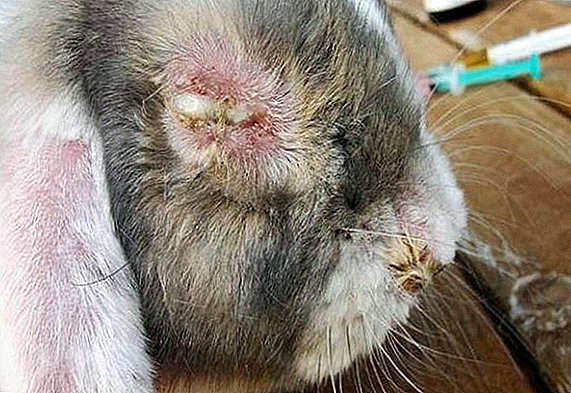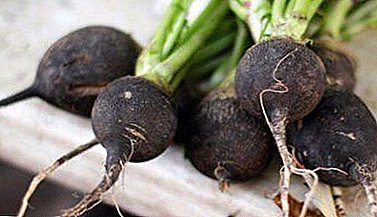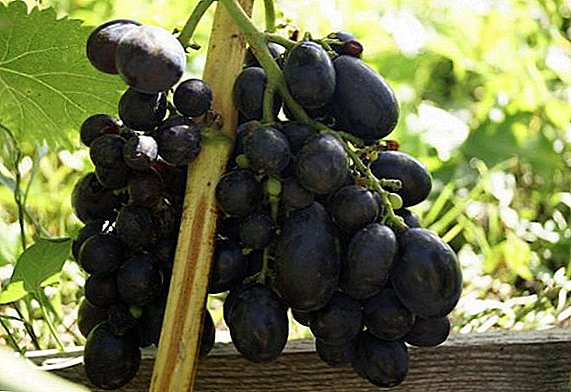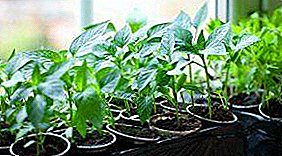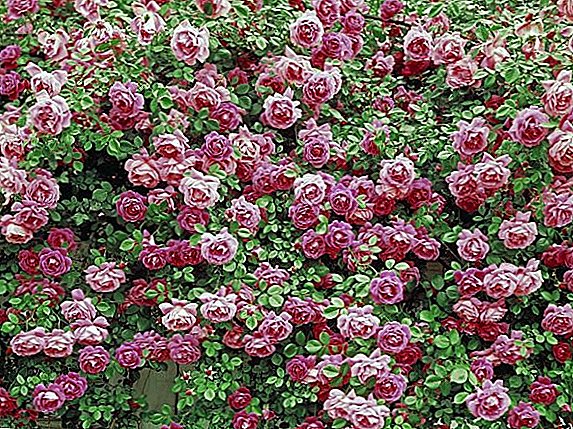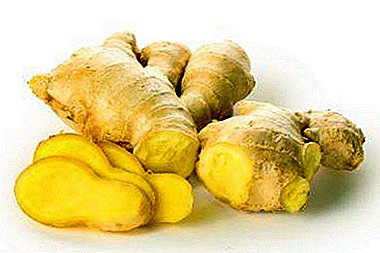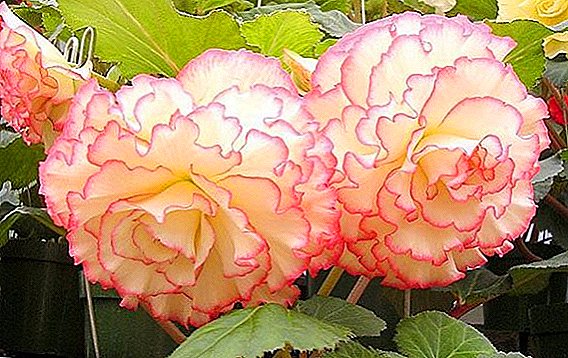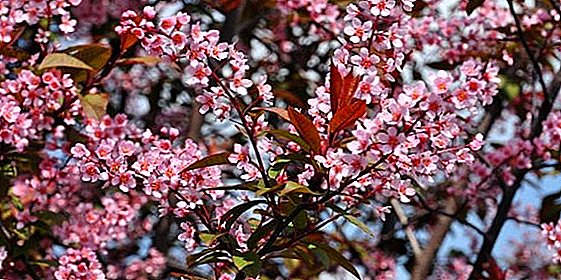 Bird-cherry in the garden is always appropriate: in the spring it hides behind a thick cloud of fragrant petals, attracts fruits in summer, dresses up in purple-purple foliage in autumn and does not lose its decorative effect even in winter. Breeders of several years improved the basic plant species, conjuring over the cultivation of new cultivated varieties. About the characteristics and the main differences of the best hybrids will be discussed further.
Bird-cherry in the garden is always appropriate: in the spring it hides behind a thick cloud of fragrant petals, attracts fruits in summer, dresses up in purple-purple foliage in autumn and does not lose its decorative effect even in winter. Breeders of several years improved the basic plant species, conjuring over the cultivation of new cultivated varieties. About the characteristics and the main differences of the best hybrids will be discussed further.
Did you know? Legends retell the story of the transformation of an offended girl, who changed the groom, into a small tree with tart berries. For dark cherry branches and black fruits, they began to call him "bird cherry".
"Colorate"
The main distinguishing features of the variety bird cherry "Colorate" (Prunus padus "Colorata") are a delicate, very decorative spherical crown with purple foliage, which eventually changes color to brownish-green shades, and pale pink flowers with a muted almond fragrance.  The trunk may develop in the form of a tree or shrub. In height reaches 6-7 m, wide forks to 5 m. Young branches are slightly sagging, of an unusual violet-purple hue.
The trunk may develop in the form of a tree or shrub. In height reaches 6-7 m, wide forks to 5 m. Young branches are slightly sagging, of an unusual violet-purple hue.
With age, they acquire a bronze ebb. The berries are small, black, attached to red petioles, it tastes sweet, slightly tart. Ripen in early August. The rhizome is dense, located mainly in the upper layers of the soil.  When cutting the trunk root processes are formed, which soon give a thick growth. The plant rapidly develops until the age of five, and then suspends growth.
When cutting the trunk root processes are formed, which soon give a thick growth. The plant rapidly develops until the age of five, and then suspends growth.
Variety "Colorate" is characterized by shade-tolerance, but still prefers sunny areas, and once in the shade, ceases to bloom and loses purple tones on the foliage. The plant loves moisture and fertile substrates.
Together with bird cherry in your garden you will look beautiful zizifus, plum, cherry plum, pear, cherry and apricot.Quickly adapts after transplanting. It has a high frost resistance. It needs watering during droughts and requires regular preventive disinfection from harmful insects. In the garden, a bird cherry can be planted in a composite or singly.
Important! From powdery mildew and rot on inflorescences, spraying the shrub with Bordeaux liquid (1%) or copper chlorine oxide (50%) will save it.
"Red Tent"
Variety refers to the decorative varieties of bird cherry. It is a low tree, up to 4 m tall and wide, with a compact, branched crown in the shape of a wide oval. The branches depart from the trunk at a right angle, the ends are directed into the sky.  The bark is gray with brown tint, slightly flakes on the trunk. The oval-shaped leaves with a pointed top of green color, which closer to July smoothly flows into purple. White inflorescences, strongly smell.
The bark is gray with brown tint, slightly flakes on the trunk. The oval-shaped leaves with a pointed top of green color, which closer to July smoothly flows into purple. White inflorescences, strongly smell.
Berries are black with a glossy smooth surface, in terms of ripeness belong to the middle late. The culture tolerates severe frosts and prolonged heat; it cannot survive for long without moisture.  Facilitates care for the cherry tree varieties "Red Tent" vaccinated her endurance gene during attacks of pests and pathogens.
Facilitates care for the cherry tree varieties "Red Tent" vaccinated her endurance gene during attacks of pests and pathogens.
"Tenderness"
The authorship of this species of bird cherry belongs to the Crimean breeders. The variety differs from other counterparts corresponding to the name of small flowers of rich red color, which form large brushes.
The tree does not grow taller 3.5 mcrown diameter about 4 m. The branches are thick, form a pyramid. When the "Tenderness" blooms, a steady aroma spreads around. Petals at the end of flowering smoothly lose their purple tones and become white and pink.  The berries are medium in size, sweet and astringent. The culture intensively develops in wet soil, can adapt to shady areas, and is resistant to frosts. In landscape design, these plants are often used to design alleys or create flowering compositions on lawns.
The berries are medium in size, sweet and astringent. The culture intensively develops in wet soil, can adapt to shady areas, and is resistant to frosts. In landscape design, these plants are often used to design alleys or create flowering compositions on lawns.
Did you know? In some Asian nations there is a ban on bouquets of flowering branches of bird cherry. Superstitions explain this fact by the fact that the tree is turned in prayer to God and will necessarily indicate the Almighty to the one who broke his hands and twisted his fingers.
"Gull"
This variety is desirable in every garden, because it is characterized by increased decorativeness, which is created by large inflorescences and bird cherry leaves. The length of the brushes of this variety reaches 15 cm, each of them has about 30 large white flowers.  The leaves develop in the form of an ellipse, each up to 12-15 cm. The tree grows medium height, has a spreading crown. It has a strong aroma. Well take root in sunny areas. Prefers moisture-holding soils. Adapt to moderate frosts. This is a decorative and very interesting variety.
The leaves develop in the form of an ellipse, each up to 12-15 cm. The tree grows medium height, has a spreading crown. It has a strong aroma. Well take root in sunny areas. Prefers moisture-holding soils. Adapt to moderate frosts. This is a decorative and very interesting variety.
On your site you can experiment enough. Try to grow such species and varieties of fruit trees as: pear "Elena", hazel, Vladimirskaya cherry and Chocolate Chocolate cherry, Northern Synaph apple tree, Prince March apricot, Revna cherry cherry tree and Eurasia plum
Virginian
Prunus virgin (Padus virginiana) is particularly popular in Europe. It spread from North America, where it grows on the shores of rivers and lakes. According to the description, the species is close to our ordinary culture.
Distinctive characteristics are protruding, rather than flattened, short buds (about 7 mm long). Under favorable conditions, the trunk is pulled up to 15 m, it is covered with dark brown bark with small cracks. The branches form a wide crown.  The leaves resemble an elongated egg. In spring, they are brown-green, and during the growing season they acquire a dark green color, which changes to bright colors in autumn. Blooms profusely with white petals. The berries are red at first, and become black as they ripen, sweet-tart, juicy.
The leaves resemble an elongated egg. In spring, they are brown-green, and during the growing season they acquire a dark green color, which changes to bright colors in autumn. Blooms profusely with white petals. The berries are red at first, and become black as they ripen, sweet-tart, juicy.
The fruiting phase begins with 7 years. Uncollected crop dries and remains on the stalks until the next flowering. In the care requires regular moisture in the heat, has a high resistance to frost, drought and harmful bacteria, pests.  It adapts to the shade, but it is better to grow in a well-lit area. It has many forms, among which deserve attention. 'Schubert', 'Atropurpurea', 'Wilpert', 'Leucocarpa'.
It adapts to the shade, but it is better to grow in a well-lit area. It has many forms, among which deserve attention. 'Schubert', 'Atropurpurea', 'Wilpert', 'Leucocarpa'.
Important! To aphid, bird cherry moth and tsvetouedy not spoil the plant, treat it with insecticides ("Iskra", "Aktara", "Bi-58 New").
Pennsylvania
This species of bird cherry also migrated to our latitudes from the regions of North America. In the wild, trees Padus pennsylvanica can be found in the forests and along the reservoirs.
Culture as it develops can grow in the form of a stem tree or shrub up to 12 m. The bark on the shoots is red-cherry. Young sprouts have a more saturated color and shine. The krone is oval, friable.  Leaf Type in Pennsylvanian Bird Cherry oblong-lanceolate. In the spring foliage green and glossy, and in the fall - red. Inflorescences are white, lush. The tree comes into fruition from the third year of life. The berries are small, dark red color.
Leaf Type in Pennsylvanian Bird Cherry oblong-lanceolate. In the spring foliage green and glossy, and in the fall - red. Inflorescences are white, lush. The tree comes into fruition from the third year of life. The berries are small, dark red color.
The view is characterized by winter hardiness and low soil requirements. The root system produces dense growth. Taking into account these features of culture, it becomes clear that it spreads up to the Polar region. Very sensitive to haircut.
"Siberian Beauty"
It is one of the many forms of ordinary bird cherry. It is a tree before 7 m tall with a thickened crown in the form of a narrow pyramid. At the beginning of the growing season the foliage is green, and since July it is poured with a dark red crimson.  The inflorescences are medium in size, half-peaked, with small white flowers. Fruits are black, with a more pronounced tartness than other varieties. The tree winters very well, adapts to any moisture-resistant substrates. Gardeners used to create composite landscapes.
The inflorescences are medium in size, half-peaked, with small white flowers. Fruits are black, with a more pronounced tartness than other varieties. The tree winters very well, adapts to any moisture-resistant substrates. Gardeners used to create composite landscapes.
Did you know? Cherry flowers are used as a natural insecticide if necessary to get rid of mosquitoes and other insects in the house. For this it is enough to leave a flowering branch indoors for half an hour.
"Bondarevskaya"
 Bird cherry "Bondarevskaya" pulled up to 6 m, has a dark green through crown. Every year gives generous yields of large sour-sweet berries with a slight tartness.
Bird cherry "Bondarevskaya" pulled up to 6 m, has a dark green through crown. Every year gives generous yields of large sour-sweet berries with a slight tartness.
Among other varieties advantageously stands out resistance to frost, pests and diseases.
It needs prophylactic treatment with potent pesticides from aphids, does not tolerate dryness.
"Thick"
The variety is a medium tall tree up to 4.5 m with a gray rough trunk and aspiring upward thin shoots of light brown shades. The leaves are small in the form of elongated oval green.
White buds, very densely arranged in inflorescences in a total of up to 40 units. Fruits are flat-rounded in shape with a black surface and yellow juicy pulp. On very ripe specimens inside are visible maroon veins.  According to taste, the berries of the bird cherry are evaluated on 4.4 points, have a sweet-sour tart taste. Suitable for raw consumption, drying and home canning.
According to taste, the berries of the bird cherry are evaluated on 4.4 points, have a sweet-sour tart taste. Suitable for raw consumption, drying and home canning.
The plant is characterized by high cold resistance, resistance to aphid attacks and stable fruiting. Among the negative differences of the variety is high sensitivity to haws and bird cherry elephantsas well as poor rooting of cuttings.


